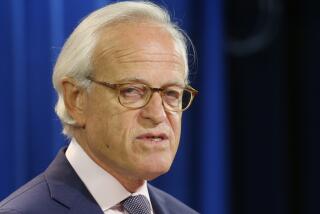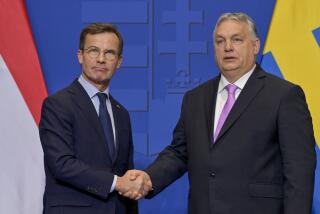A Swedish Middleman Works the Middle East
- Share via
WASHINGTON — In the world of ultra-visible shuttle diplomacy and public posturing, Sweden went the other way, applying diplomatic techniques that have lately been discarded by other nations. What Sweden achieved may prove monumental, helping to bring together the United States and the Palestine Liberation Organization for their first political dialogue.
The quiet Swedish approach proceeded from a recognition of reality: An increasingly lethal deadlock between Israel and the Palestinians in the occupied territories had become intolerable for the parties directly involved and could become intolerable for the rest of the world--the threat of a new major Middle East conflict was beginning to emerge.
Swedish Foreign Minister Sten Sture Andersson came to that conclusion when he visited Israel, Egypt, Jordan and Syria last spring--a tour marked by close personal relations with Arab as well as Israeli leaders. Andersson recognized that extreme exhaustion and hopelessness had developed in the Israeli-Palestinian confrontation, and that therefore--classically--the time was ripe for outside mediation.
Traditional diplomacy is based on the tenet that premature mediations not only tend to fail but often aggravate explosive situations. Yet there is a moment to act and that moment must be seized; for Andersson, it came upon his return.
He set up a special task force in the Foreign Ministry, reminding members that self-designated mediators must be discreet and deliberate; a great deal of preparation is required before any such effort has the chance of success. Stockholm’s advantage was that Sweden enjoys, as few nations do, real respect and confidence on all sides--from Washington to Tunis (headquarters for the PLO), from Cairo to Jerusalem. Respect for the mediator is an absolute prerequisite for diplomatic success.
Andersson--a cordial, soft-spoken but tough and tenacious man--was building on a long tradition of Swedish peace-making in the Middle East and history gave him greater credibility.
Count Folke Bernadotte of Sweden was the U.N. mediator when the state of Israel was created; he was charged with implementing the partition resolutions for former Palestine. He was assassinated in 1948, by members of a Jewish terrorist organization that operated outside Israeli army discipline.
In 1957, a Swede was U.N. secretary general. Dag Hammarskjold negotiated the peace terms following Israel’s successful Sinai campaign against Egypt. In 1961, he was to die on another peace mission, to Zaire, in a mysterious plane crash.
Then, after the 1967 Middle East War, the U.N. Security Council named Gunnar V. Jarring, a former Swedish ambassador to the United States, as mediator in the region.
Olof Palme was a U.N. mediator in the Iran-Iraq War, first as a diplomat and then as prime minister when his Social Democratic Party was returned to power. Like Bernadotte and Hammarskjold, Palme, a man of peace, died violently; he was murdered on a Stockholm street in 1986.
Andersson was facing a new, wholly intractable situation in 1988. Palestinian uprisings, the intifada , were in full swing at the West Bank and Gaza. Israel was determined to rely on military strength to put them down. The Israelis said they would not, under any circumstances, deal with the PLO and its exiled leaders. Then-Foreign Minister Shimon Peres made that clear to Andersson when they conferred in Jerusalem.
Yet Andersson was convinced that PLO participation in any peace process was absolutely essential; key players could not be left out of any diplomatic initiative. Since Israel rejected contacts, Andersson decided that the PLO had to be brought into the picture through a dialogue with the United States and that, sooner or later, some form of rapport between Israel and the PLO would become inevitable.
This was both a risky and exacting undertaking. Since 1975, the United States had been adamant: America would not meet with the PLO until the Palestinians formally recognized the existence of the state of Israel, accepted U.N. resolutions on regional peace guarantees and officially renounced terrorism. In 1978, Andrew Young, the U.S. ambassador to the United Nations, had been fired for holding secret meetings with PLO officials. During the last 13 years, the PLO had been equally adamant about not yielding to U.S. demands. Yasser Arafat and his highly emotional associates seemed committed to permanent warfare against Israel.
Andersson’s self-assigned task was to convince the Reagan Administration that Arafat and company could be persuaded to reverse their position on the U.S. demands in order to meet with American officials. Then he had to convince the Palestinians that such meetings would be in their interest.
The Swede’s ability to understand Arab thinking--an ability to see beyond public posture--was the key to conducting his quiet diplomacy. Arafat, Andersson believed, realized that uprisings inside Israeli and terrorism outside Israel would never produce a Palestinian homeland. Contact with Egyptian and Saudi Arabian officials reenforced his belief that the PLO was ready for diplomacy and a gesture to court international opinion.
When Sweden’s king and queen visited Washington last April, Andersson had an extracurricular conversation with Secretary of State George P. Shultz, to share views and to suggest that Sweden was thinking about launching a diplomatic initiative. Shultz said nothing to discourage Andersson.
The next step was to have Ulf Hjertonsson, Sweden’s No. 2 man in the Washington embassy, arrange a meeting between Arafat and a group of distinguished American Jews. (The Swedes had tried for a similar session in 1983 but the timing was wrong.)
Such a meeting, the Swedes thought, would help impel a U.S.-PLO dialogue, enabling each side to see that the other was not a demon. Andersson also thought that an American Jewish group would ease the way for the United States to accept contact with the PLO. Hjertonsson asked Stanley Sheinbaum of Los Angeles, a publisher and a regent of the University of California, to assemble the group.
Then, in July, Jordan’s King Hussein announced that he no longer felt responsibility for the West Bank. That underlined for Andersson the need to play his PLO card. Finally, Arafat and his colleagues met with the American Jewish delegates at a palace on the outskirts of Stockholm, seven months after the quiet diplomacy was launched. At that session, Arafat moved toward meeting American requirements for a joint U.S.-PLO dialogue. The PLO was telling the world that it was ready to reach out and adopt new policy.
The rest is contemporary history: In Geneva earlier this month, Arafat specifically confirmed having met U.S. dialogue demands (after further prodding by Andersson and Arab governments). Shultz, as he had promised the Swedes, accepted Arafat’s words. The first U.S.-PLO meeting followed on Dec. 16 in Tunis.
The future, of course, remains unpredictable. Last week, Israel formed a new government to contend with a new situation. A new U.S. Administration will be contending with it next month. Arafat’s PLO leadership is always subject to challenge. But the way to peace in the Middle East was a route planned in faraway Stockholm, charted along the lines of classical diplomacy.
More to Read
Sign up for Essential California
The most important California stories and recommendations in your inbox every morning.
You may occasionally receive promotional content from the Los Angeles Times.










